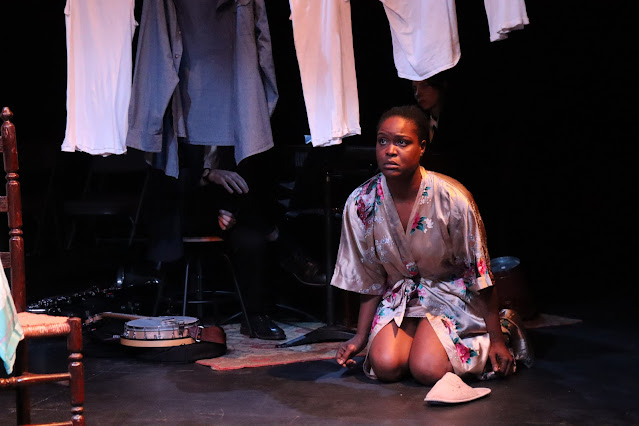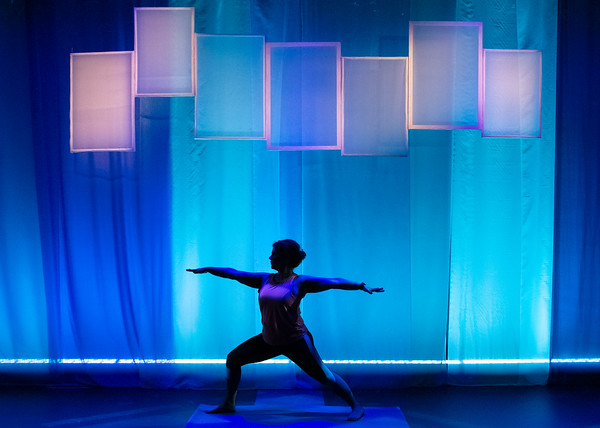Review: “She Remembers her Amnesia” Extracts Art from the Abyss
She Remembers her Amnesia
Written and performed by Janis Brenner
Presented at Arts on Site
12 St. Mark's Place, Manhattan, NYC
November 9-10, 2022
 |
| Janis Brenner. Photo by Julie Lemberger. Lighting by Mitchell Bogard. |
Indeed, how did she get here?
The immediate aftermath of this dramatic episode of extended memory loss in 2017 saw Brenner wading through her own whirling existential questions as well as inscrutable medical-speak offered by doctors. Where the words and advice of doctors failed, Brenner turned to art and created She Remembers her Amnesia.
No stranger to the solo show, Janis Brenner holds a longstanding career as a dancer, choreographer, singer, teacher, collagist, and Artistic Director. She Remembers her Amnesia is set to a musical score by Jerome Begin, the third time Brenner and Begin have collaborated.
Through the show’s genres of dance, music, spoken word, comedy, recorded sound, and visual art, Brenner mesmerizingly embodies a wide range of states of being: from the absent and disoriented, to the feeble and weak, to the joyfully absurd and operatic. The result? An audience who has entered into an experience of a shared sense of grace and earnest spirituality.
The second scene of the show enacts a troubling dialogue between Brenner and her doctor. Conjuring the voices and physical expressions of both the doctor and herself, Brenner excels as both cold medical professional and shocked patient. She portrays the doctor delivering her medical status in rigid, straightlaced, and stalwart body language. In contrast, as herself, Brenner rocks, rollicks, and reels off of the chair, falling through space in shocked reaction to the doctor’s lexicon of medical acronyms and terminologies that sound both horrifying and also impossible to understand.
The second scene of the show enacts a troubling dialogue between Brenner and her doctor. Conjuring the voices and physical expressions of both the doctor and herself, Brenner excels as both cold medical professional and shocked patient. She portrays the doctor delivering her medical status in rigid, straightlaced, and stalwart body language. In contrast, as herself, Brenner rocks, rollicks, and reels off of the chair, falling through space in shocked reaction to the doctor’s lexicon of medical acronyms and terminologies that sound both horrifying and also impossible to understand.
What Brenner discovers, from the doctor, is that if she had not had that experience of amnesia, she never would have discovered what turned out to be two aneurysms. Although, thank goodness, the doctor says, she did not have a stroke. What she did experience was transient global amnesia or, TGA. She drolly advises, “Don't do it. Skip it. Avoid it.”
 |
| Janis Brenner. Photo: Julie Lemberger. Lighting: Mitchell Bogard |
Brenner's transitions between scenes artfully recreate her sense of disorientation and loss during amnesia. In a most feeble and gentle voice, she sings and talks herself through changing costumes on stage only to realize that perhaps the costume change is wrong and she has to redo it. The intentional vulnerability in these behind-the-scenes moments provides high contrast to the powerful music and dance in the main scenes of the show.
The scene called Incidental Finding packs a powerful punch for its sheer joy and delight. She begins with her playful line, “So let me get this straight…” which is followed by any number of confounding facts physicians have relayed to her about her medical condition. The music is dance club vibe. She's mocking in the way she's talking to the doctor –laughter spilling out. She even invites the audience to get up and dance with her—an invitation that feels natural—offering the promise of catharsis.
Embracing confusion continues to be one of the hallmarks of Brenner’s work. Calling upon audio recordings, Brenner offers a recorded voice of herself and then her own on-stage voice two seconds behind it, so that we have her recorded questions about her condition and then her real-life questions on top of these. Staccato bewilderment emerges, palpable on the stage.
Brenner excels at searching through personal history for patterns, throughlines—some sort of sense. In an aria devoted to her concussions, Brenner revisits all of the times she has hit her head throughout her life. Some are seemingly minor moments, such as when she was two years old and bumped her head in her stroller. But then she describes when she was 24 years old and was in a bus accident with her dance company in Italy. She was almost read her last rites, but she had the presence of mind to protest against the priest who had arrived to do so.
She utters her lifelong litany of injuries, cello music floating above, in the persona of a professional opera singer, with all of the elegance and presence this role implies. The tragic-comic is a note Brenner strikes well, and it is her particular brand of comedy that seems truly original—a bit making fun, a bit wide-eyed and wondering. One memorable exchange shows her asking the doctor: “But what about these other things? What about my chronic insomnia? My osteoporosis? My bletheritis? My arthritis? My plantar fasciitis? …How about these breasts?”
 |
| Janis Brenner. Photo by Julie Lemberger. Lighting by Mitchell Bogard. |
Gradually, the show moves away from reflecting about particular diagnoses to meditating upon the body and the mind and how they define a life.
A pivotal scene in the piece finds her moving upstage to examine an original work of visual collage. Brenner’s virtuosity in this visual medium is clear as the collage reveals her life as unfurling, connected, continuing. There is opportunity in this scene for Brenner to place this visual collage closer to the audience for easier viewing. The collage might be an image used to even greater theatrical effect through projecting it large-scale upon the stage.
In a final aria of the show, Brenner’s voice rises to a sort of bird call, wordless but sweet. Her voice flutters and soars into a high range, reaching a childlike tone, as if she has bared herself to the audience, showing her innermost yearnings. Brenner’s arresting ending, in which she turns to the audience and utters, “Who are all you people?” reflects not only upon her experience during her amnesia event but also upon her very life as an artist and the intimate relationship of performer to audience.
It is a privilege to see Janice Brenner perform because of her fluency within such diverse mediums, conveying a facility that belies the complication beneath. Brenner turns the full force of her artistic talents upon the experience of seeking meaning from troubling medical phenomena. In doing so, her show She Remembers her Amnesia offers a full-throated cry into the abyss —and we come up singing and dancing.
It is a privilege to see Janice Brenner perform because of her fluency within such diverse mediums, conveying a facility that belies the complication beneath. Brenner turns the full force of her artistic talents upon the experience of seeking meaning from troubling medical phenomena. In doing so, her show She Remembers her Amnesia offers a full-throated cry into the abyss —and we come up singing and dancing.
-Cynthia Darling



Comments
Post a Comment